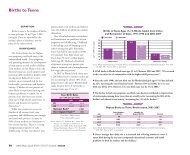2010 Rhode Island Kids Count Factbook
2010 Rhode Island Kids Count Factbook
2010 Rhode Island Kids Count Factbook
You also want an ePaper? Increase the reach of your titles
YUMPU automatically turns print PDFs into web optimized ePapers that Google loves.
Table 22.<br />
Lead Poisoning in Children Entering Kindergarten in the Fall of 2011, <strong>Rhode</strong> <strong>Island</strong><br />
Children with Lead Poisoning<br />
SCREENED WITH BLOOD LEAD LEVEL<br />
CONFIRMED WITH BLOOD LEAD LEVEL<br />
NUMBER TESTED<br />
>10 mcg/dL >10 mcg/dL<br />
CITY/TOWN FOR LEAD POISONING NUMBER PERCENT NUMBER PERCENT<br />
Barrington 160 2 1.3% 1 0.6%<br />
Bristol 222 9 4.1% 1 0.5%<br />
Burrillville 158 3 1.9% 3 1.9%<br />
Central Falls 378 20 5.3% 18 4.8%<br />
Charlestown 82 2 2.4% 1 1.2%<br />
Coventry 325 4 1.2% 4 1.2%<br />
Cranston 815 21 2.6% 16 2.0%<br />
Cumberland 365 3 0.8% 2 0.5%<br />
East Greenwich 148 0 0.0% 0 0.0%<br />
East Providence 539 16 3.0% 5 0.9%<br />
Exeter 46 0 0.0% 0 0.0%<br />
Foster 44 0 0.0% 0 0.0%<br />
Glocester 71 1 1.4% 1 1.4%<br />
Hopkinton 85 3 3.5% 0 0.0%<br />
Jamestown 32 2 6.3% 1 3.1%<br />
Johnston 266 6 2.3% 4 1.5%<br />
Lincoln 189 3 1.6% 1 0.5%<br />
Little Compton 28 5 17.9% 0 0.0%<br />
Middletown 225 5 2.2% 1 0.4%<br />
Narragansett 89 2 2.2% 1 1.1%<br />
New Shoreham 5 0 0.0% 0 0.0%<br />
Newport 340 12 3.5% 4 1.2%<br />
North Kingstown 291 5 1.7% 2 0.7%<br />
North Providence 269 2 0.7% 2 0.7%<br />
North Smithfield 96 1 1.0% 1 1.0%<br />
Pawtucket 1,056 47 4.5% 35 3.3%<br />
Portsmouth 171 2 1.2% 2 1.2%<br />
Providence 2,937 175 6.0% 151 5.1%<br />
Richmond 52 2 3.8% 2 3.8%<br />
Scituate 93 4 4.3% 2 2.2%<br />
Smithfield 155 2 1.3% 2 1.3%<br />
South Kingstown 295 4 1.4% 3 1.0%<br />
Tiverton 135 6 4.4% 0 0.0%<br />
Warren 127 6 4.7% 2 1.6%<br />
Warwick 774 18 2.3% 8 1.0%<br />
West Greenwich 52 0 0.0% 0 0.0%<br />
West Warwick 368 6 1.6% 2 0.5%<br />
Westerly 257 7 2.7% 4 1.6%<br />
Woonsocket 640 30 4.7% 20 3.1%<br />
Unknown Residence 4 0 NA 0 NA<br />
Core Cities 5,719 290 5.1% 230 4.0%<br />
Remainder of State 6,661 146 2.2% 72 1.1%<br />
<strong>Rhode</strong> <strong>Island</strong> 12,384 436 3.5% 302 2.4%<br />
Source of Data for Table/Methodology<br />
<strong>Rhode</strong> <strong>Island</strong> Department of Health, Childhood Lead<br />
Poisoning Prevention Program.<br />
Data for children entering kindergarten in the fall of<br />
2011 reflect the number of <strong>Rhode</strong> <strong>Island</strong> children<br />
eligible to enter school in the fall of 2011 (i.e., born<br />
between 9/1/05 and 8/31/06).<br />
Children who screened positive for lead poisoning (blood<br />
lead level >10 mcg/dL) are counted if they screened<br />
positive with an unconfirmed capillary test at any<br />
time in their lives prior to the end of December<br />
2009. Children confirmed positive for lead poisoning<br />
(blood lead level >10 mcg/dL) are counted if they<br />
screened positive with a venous test and/or had a<br />
confirmed capillary test at any time in their lives<br />
prior to the end of December 2009. The <strong>Rhode</strong><br />
<strong>Island</strong> Childhood Lead Poisoning Prevention<br />
Program recommends that children under age six<br />
with a capillary blood lead level of >10 mcg/dL<br />
receive a confirmatory venous test.<br />
The denominator is the number of children entering<br />
school in the fall of 2011 who were tested for lead<br />
poisoning. Screening data are based on the highest<br />
lead test result through December 2009. Data<br />
include both venous and confirmed capillary tests.<br />
Core cities are Central Falls, Newport, Pawtucket,<br />
Providence, West Warwick and Woonsocket.<br />
See Methodology Section for more information.<br />
References<br />
1,19<br />
Childhood lead poisoning in <strong>Rhode</strong> <strong>Island</strong>: The numbers<br />
2009 Edition. (2009). Providence, RI: <strong>Rhode</strong> <strong>Island</strong><br />
Department of Health, Childhood Lead Poisoning<br />
Prevention Program. Data are based on venous tests<br />
and confirmed capillary tests only. The highest result<br />
(venous or capillary) is used.<br />
2,7<br />
Brown, M. J. (2002). Costs and benefits of enforcing<br />
housing policies to prevent childhood lead<br />
poisoning. Medical Decision Making, 22(06), 482-<br />
492.<br />
3,4,11<br />
Rischitelli, G., Nygren, P., Bougatsos, C., Freeman,<br />
M. & Helfand, M. (2006). Screening for elevated<br />
lead levels in childhood and pregnancy: An updated<br />
summary of evidence for the U.S. Preventive Services<br />
Taskforce. Pediatrics, 118, 1867-1895.<br />
(continued on page 166)<br />
<strong>2010</strong> <strong>Rhode</strong> <strong>Island</strong> KIDS COUNT <strong>Factbook</strong> 73






